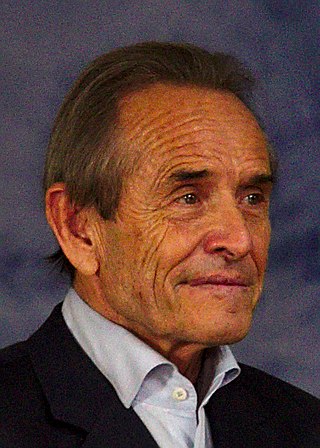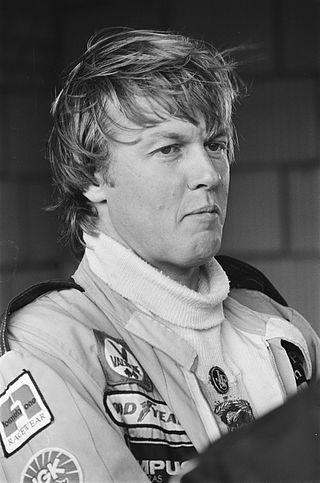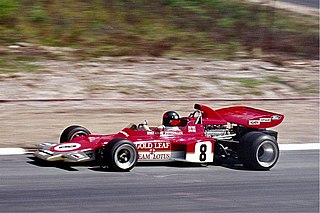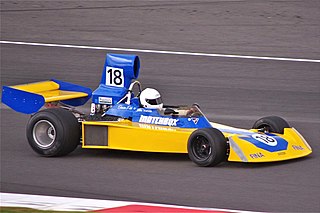
Jacques Bernard Edmon Martin Henry "Jacky" Ickx is a Belgian former racing driver who won the 24 Hours of Le Mans six times and achieved eight wins and 25 podium finishes in Formula One. He greatly contributed to several World Championships for Makes and World Sports Car championships: Ford (1968), Ferrari (1972), Porsche (1976–1977) and (1982–1985) by his 37 major World Sports Car wins. He also won the Can-Am Championship in 1979 and the 1983 Paris–Dakar Rally.

Bengt Ronnie Peterson was a Swedish racing driver. Known by the nickname 'SuperSwede', he was a two-time runner-up in the Formula One World Drivers' Championship.

The 1968 Canadian Grand Prix was a Formula One motor race held at the Circuit Mont-Tremblant in St. Jovite, Quebec, Canada on September 22, 1968. It was race 10 of 12 in both the 1968 World Championship of Drivers and the 1968 International Cup for Formula One Manufacturers. The 90-lap race was won by McLaren driver Denny Hulme after starting from sixth position. Hulme's teammate Bruce McLaren finished second and BRM driver Pedro Rodríguez came in third.

The 1969 Gran Premio de Mexico was a Formula One motor race held at the Ciudad Deportiva Magdalena Mixhuca, Mexico City on October 19, 1969, two weeks after the United States Grand Prix at Watkins Glen. It was race 11 of 11 in both the 1969 World Championship of Drivers and the 1969 International Cup for Formula One Manufacturers. The 65-lap race was won by McLaren driver Denny Hulme after he started from fourth position. Jacky Ickx finished second for the Brabham team and his teammate Jack Brabham came in third.

The 1970 Dutch Grand Prix was a Formula One motor race held at Zandvoort on June 21, 1970. It was race 5 of 13 in both the 1970 World Championship of Drivers and the 1970 International Cup for Formula One Manufacturers. This race was held the same day as the 1970 FIFA World Cup Final in Mexico City, Mexico, but that event took place later in the day from this Grand Prix.

The 1974 Argentine Grand Prix was a Formula One motor race held in Buenos Aires on 13 January 1974. It was race 1 of 15 in both the 1974 World Championship of Drivers and the 1974 International Cup for Formula One Manufacturers. The 53-lap race was won by McLaren driver Denny Hulme after he started from tenth position. Niki Lauda finished second for the Ferrari team and his teammate Clay Regazzoni came in third.

The 1977 British Grand Prix was a Formula One motor race held at Silverstone on 16 July 1977. It was the tenth race of the 1977 World Championship of F1 Drivers and the 1977 International Cup for F1 Constructors.

The 1979 British Grand Prix was a Formula One motor race held at Silverstone on 14 July 1979. It was the ninth race of the 1979 World Championship of F1 Drivers and the 1979 International Cup for F1 Constructors.

The 1974 Formula One season was the 28th season of FIA Formula One motor racing. It featured the 1974 World Championship of F1 Drivers and the 1974 International Cup for F1 Manufacturers, contested concurrently over a fifteen-race series which commenced on 13 January and ended on 6 October. The season also included three non-championship races.

The 1971 Formula One season was the 25th season of the Fédération Internationale de l'Automobile's Formula One motor racing. It featured the 22nd World Championship of Drivers and the 14th International Cup for F1 Manufacturers which were contested concurrently over eleven races between 6 March and 3 October. The season also included a number of non-championship races open to Formula One cars.

Chris Amon Racing, also known simply as Amon, was a Formula One team established by New Zealand driver Chris Amon. It competed as a privateer team in the 1966 Italian Grand Prix, then as a constructor in its own right in the 1974 Formula One season.

The Lotus 72 is a Formula One car designed by Colin Chapman and Maurice Philippe of Lotus for the 1970 Formula One season. The 72 was a pioneering design featuring inboard brakes, side-mounted radiators in sidepods, and aerodynamic wings producing down-force.

The BRM P160 was a Formula One racing car designed by Tony Southgate for the British Racing Motors team, which raced in the 1971, 1972, 1973 and 1974 Formula One seasons. It was powered by a 3.0-litre V12 engine.

The Hesketh 308C was a Formula One racing car designed by Harvey Postlethwaite and used by Hesketh Racing in the latter stages of the 1975 Formula One season. The car featured the rubber suspension which Postlethwaite had pioneered on the preceding 308B model and a Ford-Cosworth DFV engine. In 1976, the car was acquired by Wolf–Williams Racing and rebranded as the Wolf–Williams FW05.

The Lola T370 was a Formula One car designed by Andy Smallman and used by Embassy Hill in the 1974 season and the early part of the 1975 season. After an unsuccessful 1973 with a customer Shadow DN1, the Embassy Hill team commissioned its own cars from Lola. The T370 was largely based on Formula 5000 designs, and looked similar to Lola's F5000 cars, although it sported an extremely large airbox. Embassy Hill had two cars for Graham Hill and Guy Edwards. The car was tested well before the end of 1973 in readiness for the January start to the 1974 season.

The Tyrrell 002 is a Formula One racing car which was designed for the 1971 and 1972 Formula One seasons by Tyrrell's Chief Designer, Derek Gardner. It was essentially the same design as the Tyrrell 001, but incorporated some detail changes, and 002 were built with longer monocoques, as François Cevert was taller than Jackie Stewart.

The Williams FW was a Formula One car used by Frank Williams Racing Cars during the 1973, 1974 and 1975 seasons. It was designed by John Clarke.

The Williams FW04 was a Formula One car used by Frank Williams Racing Cars during the 1975 season and Wolf–Williams Racing during the 1976 season. The car was a development of the Williams FW and two were built. Although not a particularly successful car, an FW04 finished second at the 1975 German Grand Prix.

The Surtees TS16 was a Formula One car used by Surtees during the 1974, 1975 and 1976 Formula One seasons. It was designed by John Surtees.
The Parnelli VPJ4 was a Formula One racing car designed by Maurice Philippe, and used by Vel's Parnelli Jones Racing during the 1974, 1975 and 1976 Formula One seasons.



















